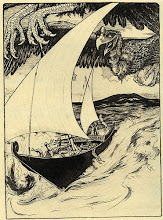Karel Zeman, director of the film, is likened to great animators of the past and especially of Czechoslovakia. Zeman was said to create “a timeless representation of prehistory, so it remains convincing even now”4 and perhaps his connection to the past links to his actual experience of the changing nation around him at the time he designed animated films. He could capture the sentiment because he lived through hardship followed by hope for the Czech community.
One of his most renowned and influential films is Journey to Prehistory, released in 1955, where he mixed imaginative media of live action with that of animation. To briefly summarize, the film follows a group of young boys who set out on a small boat, seeking adventure, which magically leads them back in time. Czech and other audiences alike fell in love with Zeman’s creative and colorful imagery because it took them out of place for a moment, as movies should, to experience something new and exciting. Sinbad, shares the same curiosity of the unknown, risk, and fortune.
In 1958, Zeman produced The Fabulous World of Jules Verne, another feature in which he mixed animation and live acting, which strongly emphasizes his zest for creativity in storytelling, much like the Arabic Nights tales were marvelous visions of tales. He carried out this passion, equally, in film. And interestingly enough, “when political situationwas at its darkest, Czechoslovakian animated film astonished the world.”2
While I watched Sinbad, the lively paper-like animation seems directed towards children, while the dialogue appeals more to adults. Talking animals and personification of other objects in the film are the fantastical whimsy of it. Older audiences, however, would likely notice symbolism in imagery such as the blinding of the eyes, which also provokes the theme of curiosity or desire for the unknown. It was evident the film would entertain children, but it seems equally pleasing for adults, a story for them to revert to their past, in the magnetic way Zeman lures us out of common reality. For this reason, it would make sense that animation was so popular during the Communist era in central Europe.
Subscribe to:
Post Comments (Atom)



No comments:
Post a Comment